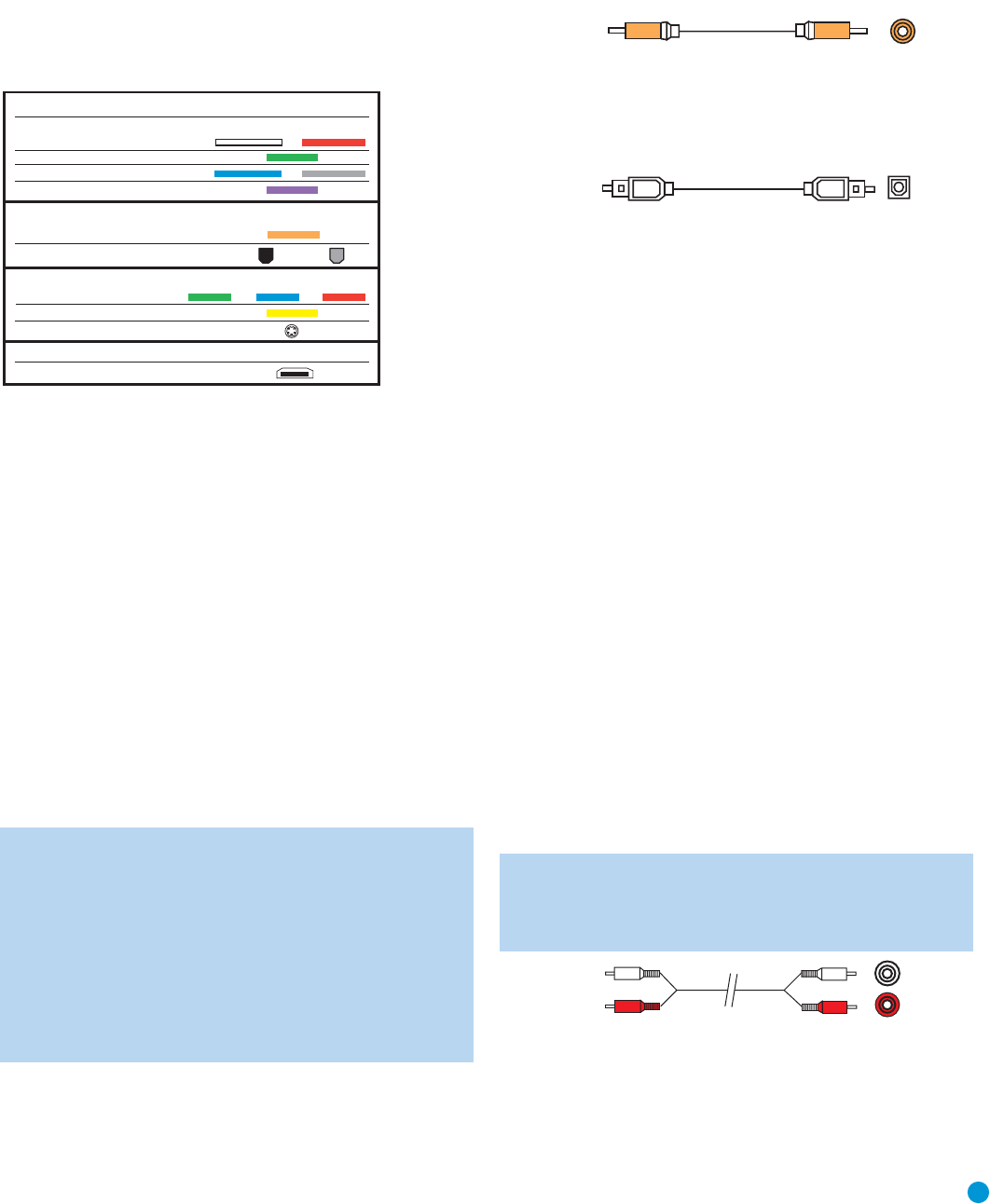
17
CONNECTIONS
There are different types of audio and video connections used to
connect the DVD 38 to your receiver or processor and video display.
To make it easier to keep them all straight, the Consumer Electronics
Association (CEA
®
) has established a color-coding standard. Table 1
may be helpful to you as a reference while you set up your system.
Table 1 – Connection Color Guide
Types of Connections
This section will briefly review different types of cables and connections
that you may use to set up your system.
Audio and video signals originate in what are known as “source
devices,” including a DVD/CD player such as the DVD 38.
Separate connections are required for the audio and video portions of
the signal unless an HDMI connection is used (see below). The types of
connections used depend upon what’s available on your receiver, and
for video signals, the capabilities of your video display.
Audio Connections
There are two formats for audio connections: digital and analog. Digital
audio signals are required for listening to sources encoded with digital
surround modes, such as Dolby Digital and DTS. There are two types
of digital audio connections commonly used: coaxial and optical. Either
type of digital audio connection may be used, but never both simultane-
ously. However, it’s okay to make both analog and digital audio connec-
tions at the same time to the same source.
NOTE: The DVD 38 outputs digital audio signals through the
HDMI connection. If your receiver/processor or video display
is capable of
processing
the audio portion of the HDMI signal,
then you will not need to make a separate digital audio connec-
tion. However, as explained in the Analog Audio section below,
you may still need to make the analog audio connections. If
your receiver/processor is only capable of
switching
HDMI
signals, use HDMI for your video connection only and connect
either the DVD 38’s coaxial or optical digital audio output to
the corresponding input on your receiver.
Digital Audio
Coaxial digital audio jacks are usually color-coded in orange. Although
they look similar to analog jacks, they should not be confused, and you
should not connect coaxial digital audio outputs to analog inputs or
vice versa. See Figure 1.
Figure 1 – Coaxial Digital Audio
Optical digital audio connectors are normally covered by a shutter to
protect them from dust. The shutter opens as the cable is inserted.
See Figure 2.
Figure 2 – Optical Digital Audio
Due to the nature of digital signals as binary bits, they aren’t subject
to signal degradation the way analog signals are. Therefore, the quality
of coaxial and optical digital audio connections should be the same,
although it is important to limit the length of the cable. Whichever type of
connection you choose, Harman Kardon recommends that you always
select the highest quality cables available within your budget.
Analog Audio
Analog connections require two cables, one for the left channel (white)
and one for the right channel (red). See Figure 3. These two cables are
often attached to each other for most of their length. Most devices that
have digital audio jacks also have analog audio jacks. We recommend
that you always connect the DVD 38’s 2-Channel Analog Audio Outputs
to your receiver/processor, or to your TV if you are not using a receiver.
There are four reasons to use analog audio connections, even if you are
using one of the digital audio connections:
1. To make recordings. Most DVDs are protected from digital copying
and only analog copies are permitted. Please make sure to comply
with all copyright laws when making recordings for personal use.
2. In a multiroom system. Many receivers and processors require
sources used in multiroom systems to output analog audio signals.
3. When connecting the DVD 38 directly to a TV. The TV may not have
digital audio inputs.
4. When playing high-resolution 96kHz PCM audio discs. If your receiver
is not capable of processing 96kHz audio, you may need to use the
analog audio connection.
NOTE: The DVD 38 is capable of downmixing multichannel
materials and outputting a two-channel downmix. However,
make sure to adjust the Bass Management setting in the Audio
Setup menu to Stereo.
Figure 3 – Analog Audio
Multichannel analog connections are used with high-resolution DVD-
Audio discs, where the copy-protected digital content is decoded inside
the DVD 38. These connections are required for playing DVD-Audio
discs, unless the disc also carries two-channel PCM and 5.1-channel
L
R
A
nalog audio
cable (RCA)
O
pt
i
ca
l
Optical digital
audio cable
Coaxial
Coaxial digital
audio cable
Audio Connections
Left Right
Front (FL/FR)
Center (C)
Surround (SL/SR)
Subwoofer (SUB)
Digital Audio Connections
Coaxial
Optical
Video Connections
Component Y Pb Pr
Composite
S-Video
HDMI
™
Connections
HDMI
Input Output
DVD 38 OM(color).qxd 2/7/07 3:57 PM Page 17


















